Assessment 3: The Global Fast Food Market and Its Harmful Effects
VerifiedAdded on 2023/04/03
|5
|1268
|325
Report
AI Summary
This report critically examines the global fast food market, highlighting its substantial growth and the detrimental effects of fast food consumption on both individual health and broader societal well-being. It emphasizes the nutritional deficiencies of fast food, including high levels of saturated fats, sugar, salt, and preservatives, which contribute to obesity, diabetes, and potential cognitive impairments. The report proposes multifaceted solutions to address these challenges, advocating for community health promotion campaigns to educate people about healthy eating habits, government interventions such as zoning laws and infrastructure development to encourage healthier food options, and measures by restaurants to provide nutritional information on menus and promote health awareness. The report references several research papers, including those by Monteiro et al. (2018), Zobel et al. (2016), Lupton (2015), and others, to support its arguments and recommendations, emphasizing the need for a comprehensive approach to mitigate the negative impacts of the global fast food market.
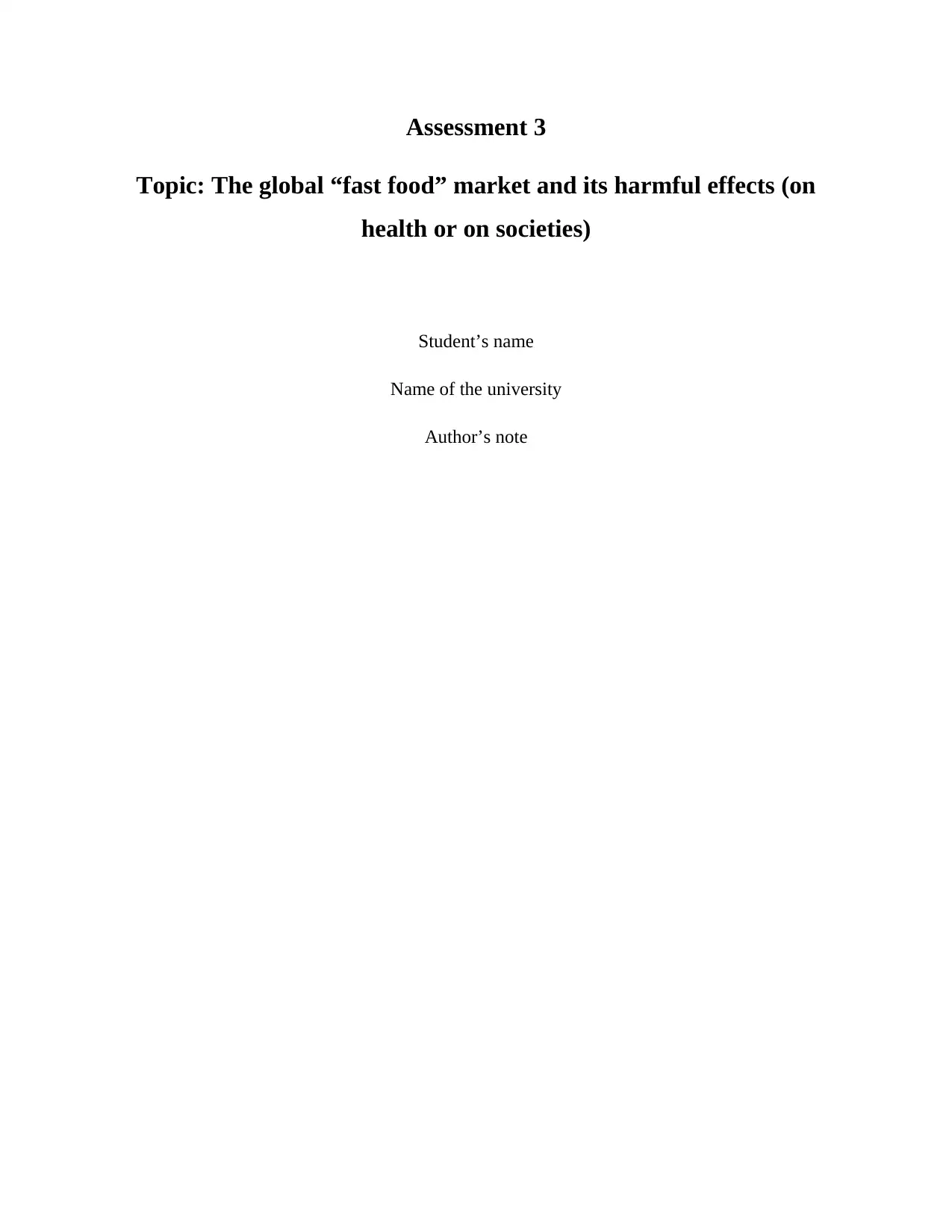
Assessment 3
Topic: The global “fast food” market and its harmful effects (on
health or on societies)
Student’s name
Name of the university
Author’s note
Topic: The global “fast food” market and its harmful effects (on
health or on societies)
Student’s name
Name of the university
Author’s note
Paraphrase This Document
Need a fresh take? Get an instant paraphrase of this document with our AI Paraphraser
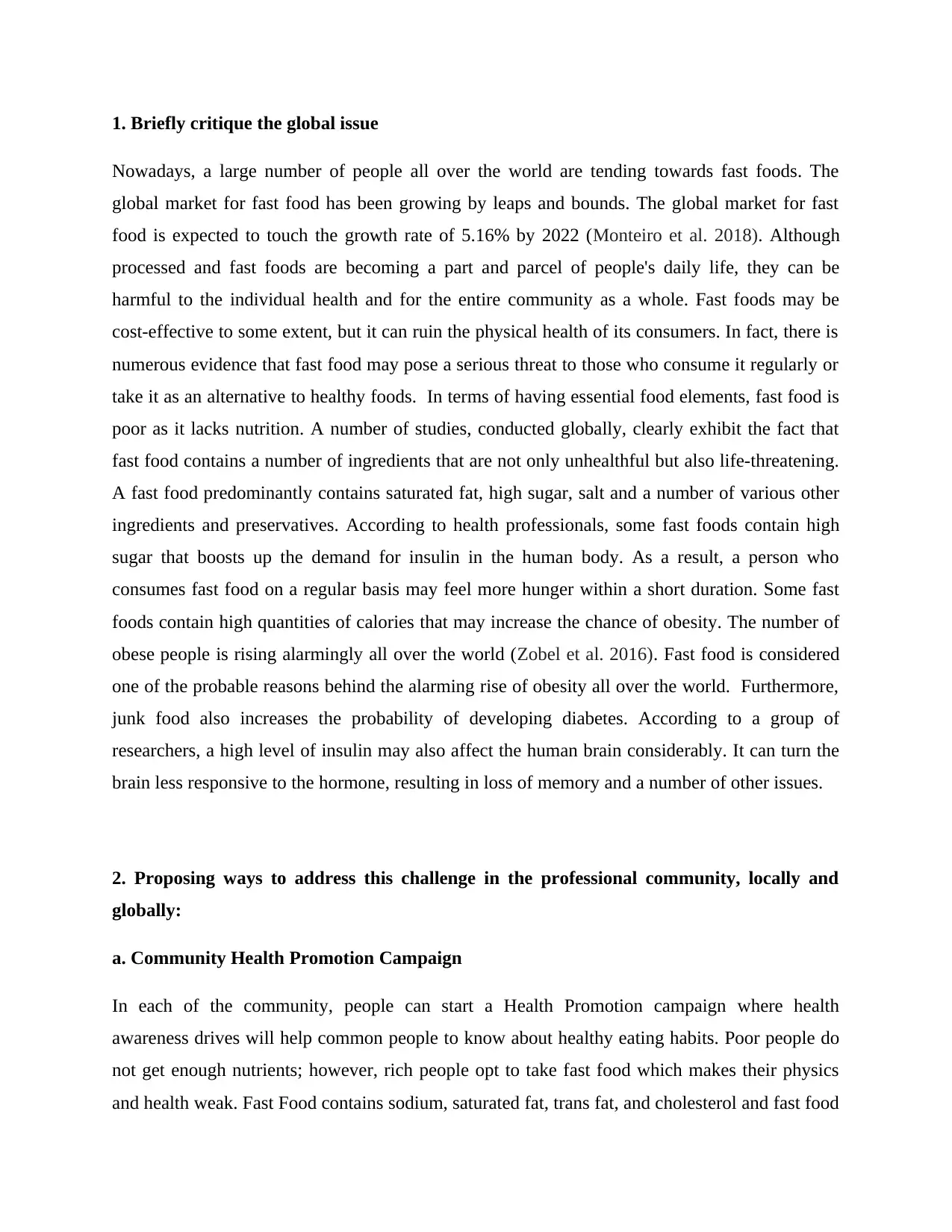
1. Briefly critique the global issue
Nowadays, a large number of people all over the world are tending towards fast foods. The
global market for fast food has been growing by leaps and bounds. The global market for fast
food is expected to touch the growth rate of 5.16% by 2022 (Monteiro et al. 2018). Although
processed and fast foods are becoming a part and parcel of people's daily life, they can be
harmful to the individual health and for the entire community as a whole. Fast foods may be
cost-effective to some extent, but it can ruin the physical health of its consumers. In fact, there is
numerous evidence that fast food may pose a serious threat to those who consume it regularly or
take it as an alternative to healthy foods. In terms of having essential food elements, fast food is
poor as it lacks nutrition. A number of studies, conducted globally, clearly exhibit the fact that
fast food contains a number of ingredients that are not only unhealthful but also life-threatening.
A fast food predominantly contains saturated fat, high sugar, salt and a number of various other
ingredients and preservatives. According to health professionals, some fast foods contain high
sugar that boosts up the demand for insulin in the human body. As a result, a person who
consumes fast food on a regular basis may feel more hunger within a short duration. Some fast
foods contain high quantities of calories that may increase the chance of obesity. The number of
obese people is rising alarmingly all over the world (Zobel et al. 2016). Fast food is considered
one of the probable reasons behind the alarming rise of obesity all over the world. Furthermore,
junk food also increases the probability of developing diabetes. According to a group of
researchers, a high level of insulin may also affect the human brain considerably. It can turn the
brain less responsive to the hormone, resulting in loss of memory and a number of other issues.
2. Proposing ways to address this challenge in the professional community, locally and
globally:
a. Community Health Promotion Campaign
In each of the community, people can start a Health Promotion campaign where health
awareness drives will help common people to know about healthy eating habits. Poor people do
not get enough nutrients; however, rich people opt to take fast food which makes their physics
and health weak. Fast Food contains sodium, saturated fat, trans fat, and cholesterol and fast food
Nowadays, a large number of people all over the world are tending towards fast foods. The
global market for fast food has been growing by leaps and bounds. The global market for fast
food is expected to touch the growth rate of 5.16% by 2022 (Monteiro et al. 2018). Although
processed and fast foods are becoming a part and parcel of people's daily life, they can be
harmful to the individual health and for the entire community as a whole. Fast foods may be
cost-effective to some extent, but it can ruin the physical health of its consumers. In fact, there is
numerous evidence that fast food may pose a serious threat to those who consume it regularly or
take it as an alternative to healthy foods. In terms of having essential food elements, fast food is
poor as it lacks nutrition. A number of studies, conducted globally, clearly exhibit the fact that
fast food contains a number of ingredients that are not only unhealthful but also life-threatening.
A fast food predominantly contains saturated fat, high sugar, salt and a number of various other
ingredients and preservatives. According to health professionals, some fast foods contain high
sugar that boosts up the demand for insulin in the human body. As a result, a person who
consumes fast food on a regular basis may feel more hunger within a short duration. Some fast
foods contain high quantities of calories that may increase the chance of obesity. The number of
obese people is rising alarmingly all over the world (Zobel et al. 2016). Fast food is considered
one of the probable reasons behind the alarming rise of obesity all over the world. Furthermore,
junk food also increases the probability of developing diabetes. According to a group of
researchers, a high level of insulin may also affect the human brain considerably. It can turn the
brain less responsive to the hormone, resulting in loss of memory and a number of other issues.
2. Proposing ways to address this challenge in the professional community, locally and
globally:
a. Community Health Promotion Campaign
In each of the community, people can start a Health Promotion campaign where health
awareness drives will help common people to know about healthy eating habits. Poor people do
not get enough nutrients; however, rich people opt to take fast food which makes their physics
and health weak. Fast Food contains sodium, saturated fat, trans fat, and cholesterol and fast food
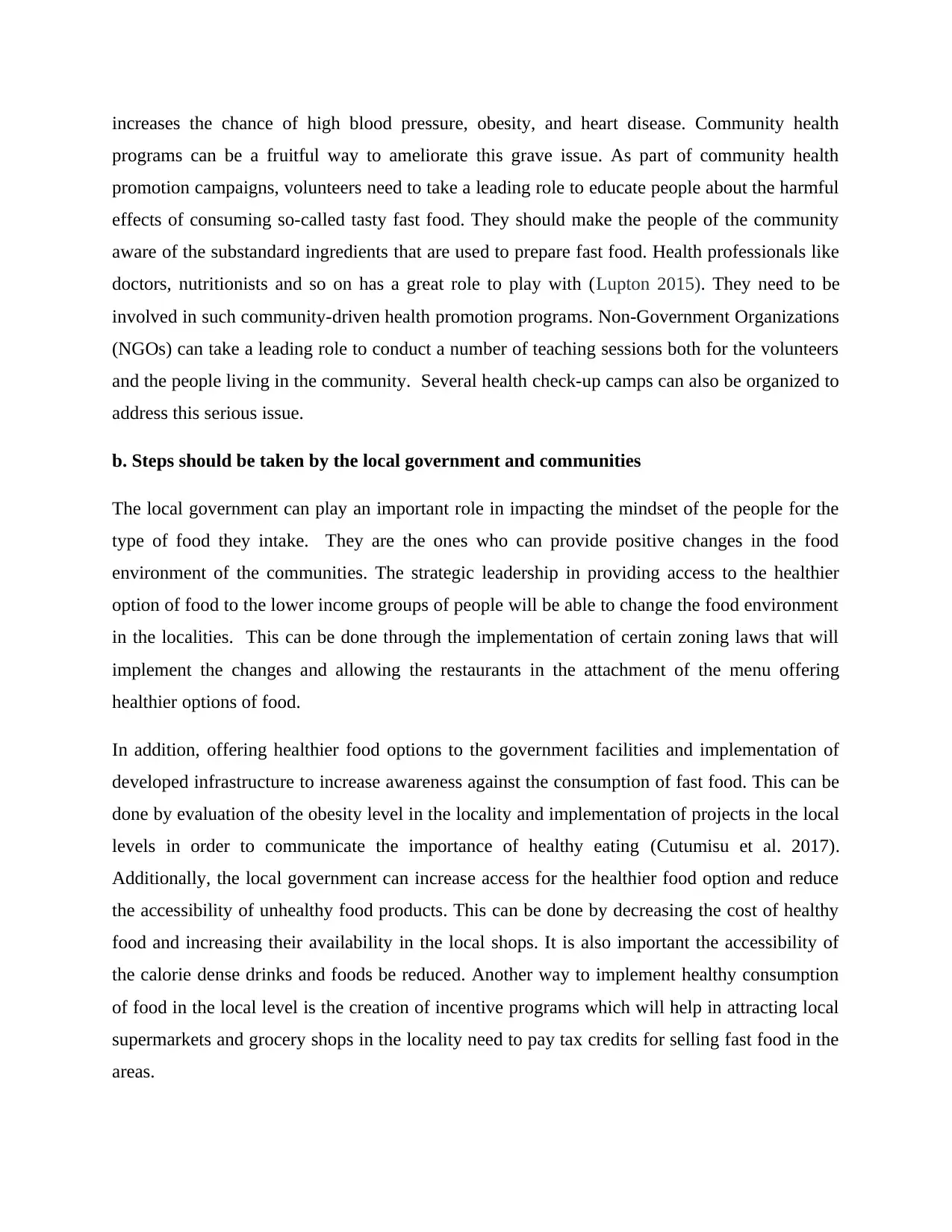
increases the chance of high blood pressure, obesity, and heart disease. Community health
programs can be a fruitful way to ameliorate this grave issue. As part of community health
promotion campaigns, volunteers need to take a leading role to educate people about the harmful
effects of consuming so-called tasty fast food. They should make the people of the community
aware of the substandard ingredients that are used to prepare fast food. Health professionals like
doctors, nutritionists and so on has a great role to play with (Lupton 2015). They need to be
involved in such community-driven health promotion programs. Non-Government Organizations
(NGOs) can take a leading role to conduct a number of teaching sessions both for the volunteers
and the people living in the community. Several health check-up camps can also be organized to
address this serious issue.
b. Steps should be taken by the local government and communities
The local government can play an important role in impacting the mindset of the people for the
type of food they intake. They are the ones who can provide positive changes in the food
environment of the communities. The strategic leadership in providing access to the healthier
option of food to the lower income groups of people will be able to change the food environment
in the localities. This can be done through the implementation of certain zoning laws that will
implement the changes and allowing the restaurants in the attachment of the menu offering
healthier options of food.
In addition, offering healthier food options to the government facilities and implementation of
developed infrastructure to increase awareness against the consumption of fast food. This can be
done by evaluation of the obesity level in the locality and implementation of projects in the local
levels in order to communicate the importance of healthy eating (Cutumisu et al. 2017).
Additionally, the local government can increase access for the healthier food option and reduce
the accessibility of unhealthy food products. This can be done by decreasing the cost of healthy
food and increasing their availability in the local shops. It is also important the accessibility of
the calorie dense drinks and foods be reduced. Another way to implement healthy consumption
of food in the local level is the creation of incentive programs which will help in attracting local
supermarkets and grocery shops in the locality need to pay tax credits for selling fast food in the
areas.
programs can be a fruitful way to ameliorate this grave issue. As part of community health
promotion campaigns, volunteers need to take a leading role to educate people about the harmful
effects of consuming so-called tasty fast food. They should make the people of the community
aware of the substandard ingredients that are used to prepare fast food. Health professionals like
doctors, nutritionists and so on has a great role to play with (Lupton 2015). They need to be
involved in such community-driven health promotion programs. Non-Government Organizations
(NGOs) can take a leading role to conduct a number of teaching sessions both for the volunteers
and the people living in the community. Several health check-up camps can also be organized to
address this serious issue.
b. Steps should be taken by the local government and communities
The local government can play an important role in impacting the mindset of the people for the
type of food they intake. They are the ones who can provide positive changes in the food
environment of the communities. The strategic leadership in providing access to the healthier
option of food to the lower income groups of people will be able to change the food environment
in the localities. This can be done through the implementation of certain zoning laws that will
implement the changes and allowing the restaurants in the attachment of the menu offering
healthier options of food.
In addition, offering healthier food options to the government facilities and implementation of
developed infrastructure to increase awareness against the consumption of fast food. This can be
done by evaluation of the obesity level in the locality and implementation of projects in the local
levels in order to communicate the importance of healthy eating (Cutumisu et al. 2017).
Additionally, the local government can increase access for the healthier food option and reduce
the accessibility of unhealthy food products. This can be done by decreasing the cost of healthy
food and increasing their availability in the local shops. It is also important the accessibility of
the calorie dense drinks and foods be reduced. Another way to implement healthy consumption
of food in the local level is the creation of incentive programs which will help in attracting local
supermarkets and grocery shops in the locality need to pay tax credits for selling fast food in the
areas.
⊘ This is a preview!⊘
Do you want full access?
Subscribe today to unlock all pages.

Trusted by 1+ million students worldwide
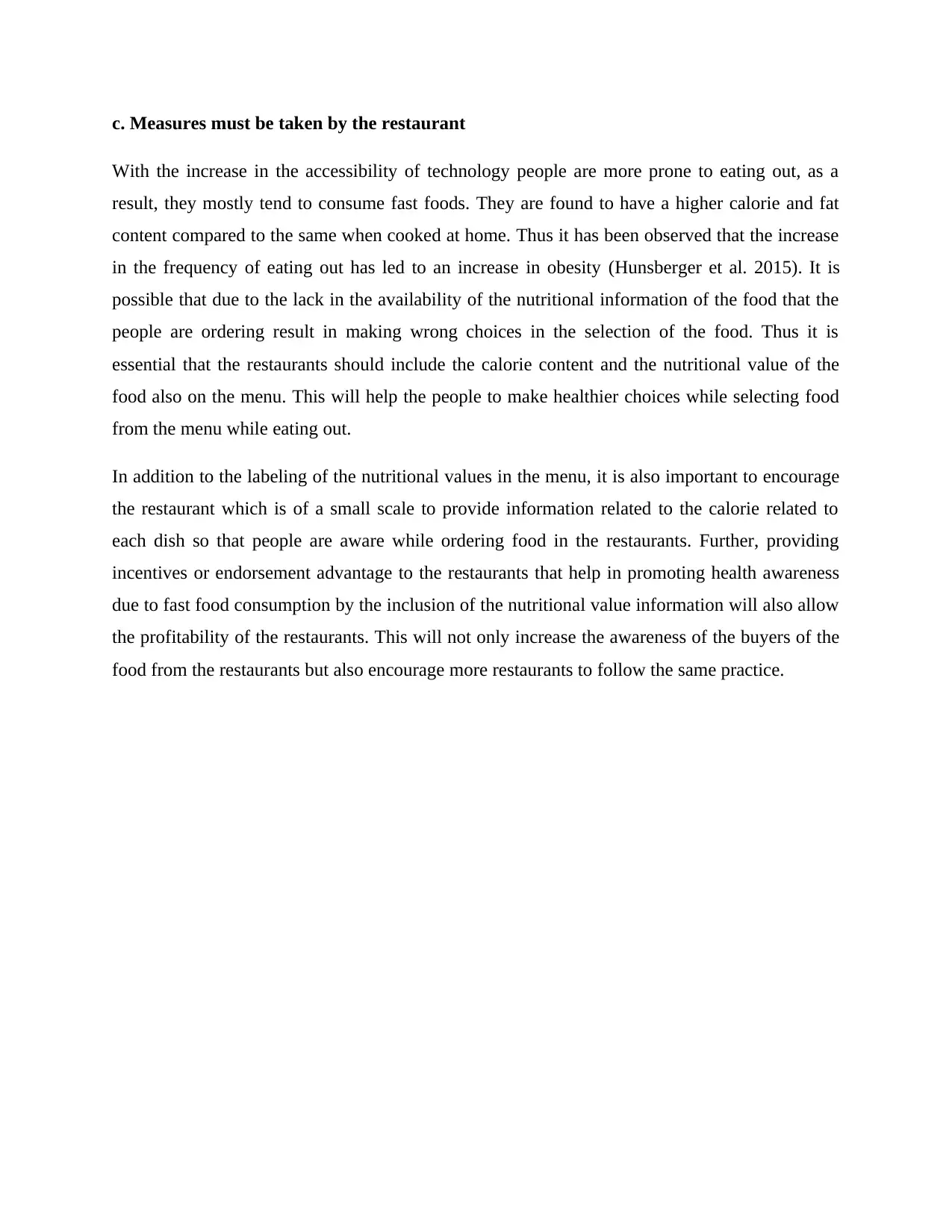
c. Measures must be taken by the restaurant
With the increase in the accessibility of technology people are more prone to eating out, as a
result, they mostly tend to consume fast foods. They are found to have a higher calorie and fat
content compared to the same when cooked at home. Thus it has been observed that the increase
in the frequency of eating out has led to an increase in obesity (Hunsberger et al. 2015). It is
possible that due to the lack in the availability of the nutritional information of the food that the
people are ordering result in making wrong choices in the selection of the food. Thus it is
essential that the restaurants should include the calorie content and the nutritional value of the
food also on the menu. This will help the people to make healthier choices while selecting food
from the menu while eating out.
In addition to the labeling of the nutritional values in the menu, it is also important to encourage
the restaurant which is of a small scale to provide information related to the calorie related to
each dish so that people are aware while ordering food in the restaurants. Further, providing
incentives or endorsement advantage to the restaurants that help in promoting health awareness
due to fast food consumption by the inclusion of the nutritional value information will also allow
the profitability of the restaurants. This will not only increase the awareness of the buyers of the
food from the restaurants but also encourage more restaurants to follow the same practice.
With the increase in the accessibility of technology people are more prone to eating out, as a
result, they mostly tend to consume fast foods. They are found to have a higher calorie and fat
content compared to the same when cooked at home. Thus it has been observed that the increase
in the frequency of eating out has led to an increase in obesity (Hunsberger et al. 2015). It is
possible that due to the lack in the availability of the nutritional information of the food that the
people are ordering result in making wrong choices in the selection of the food. Thus it is
essential that the restaurants should include the calorie content and the nutritional value of the
food also on the menu. This will help the people to make healthier choices while selecting food
from the menu while eating out.
In addition to the labeling of the nutritional values in the menu, it is also important to encourage
the restaurant which is of a small scale to provide information related to the calorie related to
each dish so that people are aware while ordering food in the restaurants. Further, providing
incentives or endorsement advantage to the restaurants that help in promoting health awareness
due to fast food consumption by the inclusion of the nutritional value information will also allow
the profitability of the restaurants. This will not only increase the awareness of the buyers of the
food from the restaurants but also encourage more restaurants to follow the same practice.
Paraphrase This Document
Need a fresh take? Get an instant paraphrase of this document with our AI Paraphraser
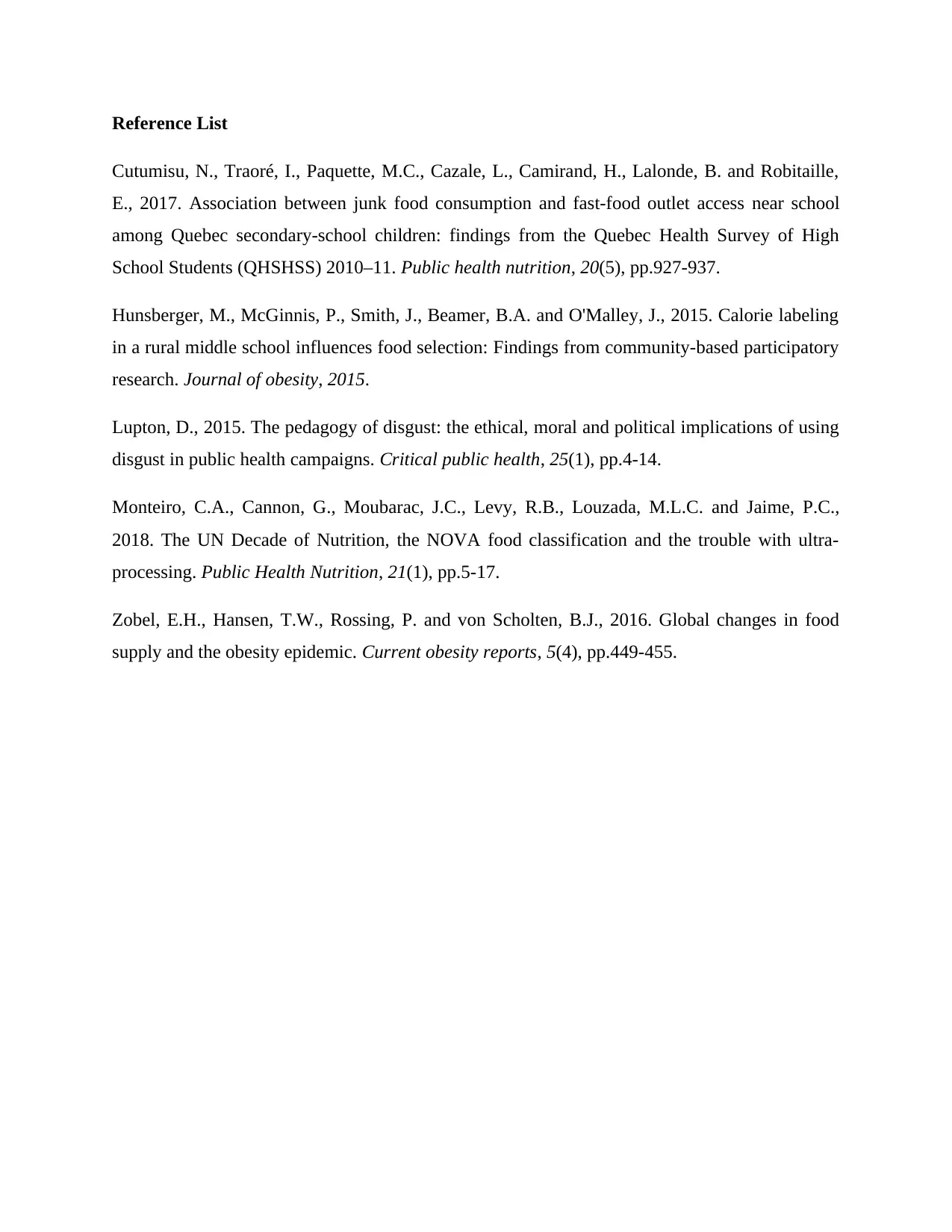
Reference List
Cutumisu, N., Traoré, I., Paquette, M.C., Cazale, L., Camirand, H., Lalonde, B. and Robitaille,
E., 2017. Association between junk food consumption and fast-food outlet access near school
among Quebec secondary-school children: findings from the Quebec Health Survey of High
School Students (QHSHSS) 2010–11. Public health nutrition, 20(5), pp.927-937.
Hunsberger, M., McGinnis, P., Smith, J., Beamer, B.A. and O'Malley, J., 2015. Calorie labeling
in a rural middle school influences food selection: Findings from community-based participatory
research. Journal of obesity, 2015.
Lupton, D., 2015. The pedagogy of disgust: the ethical, moral and political implications of using
disgust in public health campaigns. Critical public health, 25(1), pp.4-14.
Monteiro, C.A., Cannon, G., Moubarac, J.C., Levy, R.B., Louzada, M.L.C. and Jaime, P.C.,
2018. The UN Decade of Nutrition, the NOVA food classification and the trouble with ultra-
processing. Public Health Nutrition, 21(1), pp.5-17.
Zobel, E.H., Hansen, T.W., Rossing, P. and von Scholten, B.J., 2016. Global changes in food
supply and the obesity epidemic. Current obesity reports, 5(4), pp.449-455.
Cutumisu, N., Traoré, I., Paquette, M.C., Cazale, L., Camirand, H., Lalonde, B. and Robitaille,
E., 2017. Association between junk food consumption and fast-food outlet access near school
among Quebec secondary-school children: findings from the Quebec Health Survey of High
School Students (QHSHSS) 2010–11. Public health nutrition, 20(5), pp.927-937.
Hunsberger, M., McGinnis, P., Smith, J., Beamer, B.A. and O'Malley, J., 2015. Calorie labeling
in a rural middle school influences food selection: Findings from community-based participatory
research. Journal of obesity, 2015.
Lupton, D., 2015. The pedagogy of disgust: the ethical, moral and political implications of using
disgust in public health campaigns. Critical public health, 25(1), pp.4-14.
Monteiro, C.A., Cannon, G., Moubarac, J.C., Levy, R.B., Louzada, M.L.C. and Jaime, P.C.,
2018. The UN Decade of Nutrition, the NOVA food classification and the trouble with ultra-
processing. Public Health Nutrition, 21(1), pp.5-17.
Zobel, E.H., Hansen, T.W., Rossing, P. and von Scholten, B.J., 2016. Global changes in food
supply and the obesity epidemic. Current obesity reports, 5(4), pp.449-455.
1 out of 5
Related Documents
Your All-in-One AI-Powered Toolkit for Academic Success.
+13062052269
info@desklib.com
Available 24*7 on WhatsApp / Email
![[object Object]](/_next/static/media/star-bottom.7253800d.svg)
Unlock your academic potential
Copyright © 2020–2025 A2Z Services. All Rights Reserved. Developed and managed by ZUCOL.





